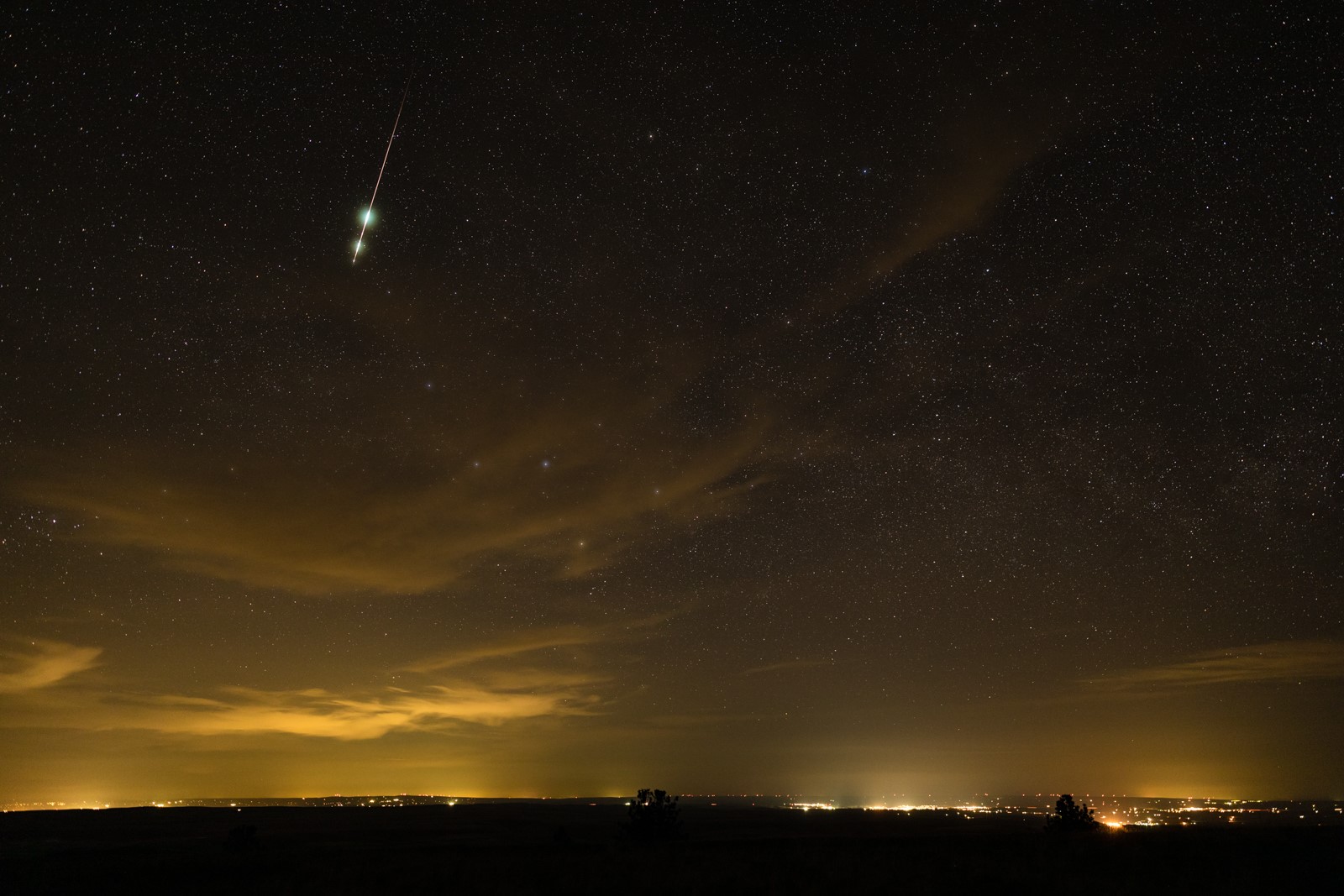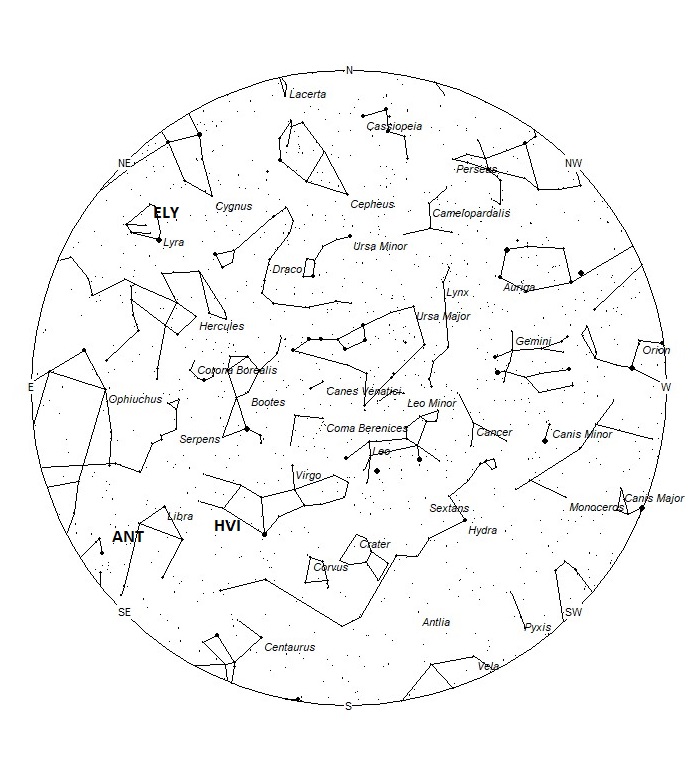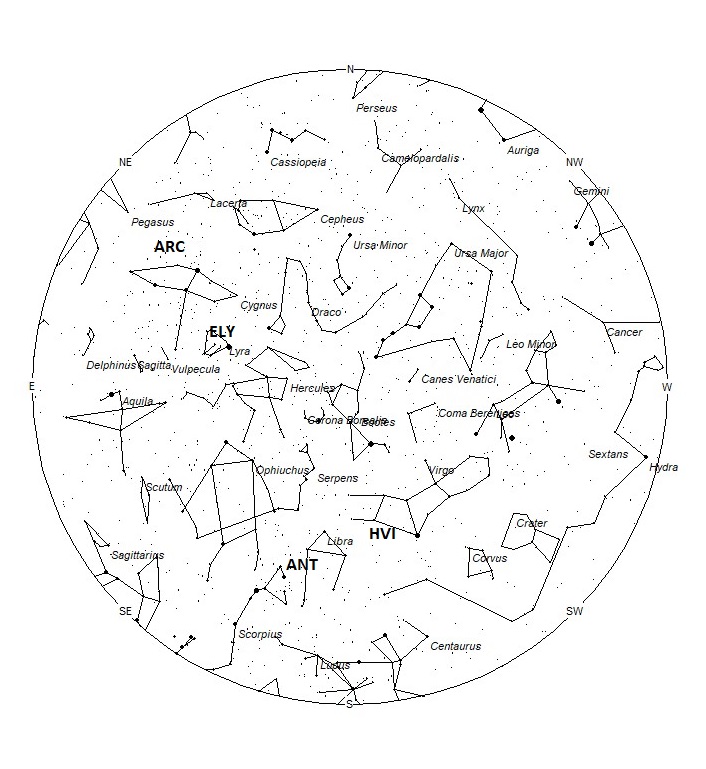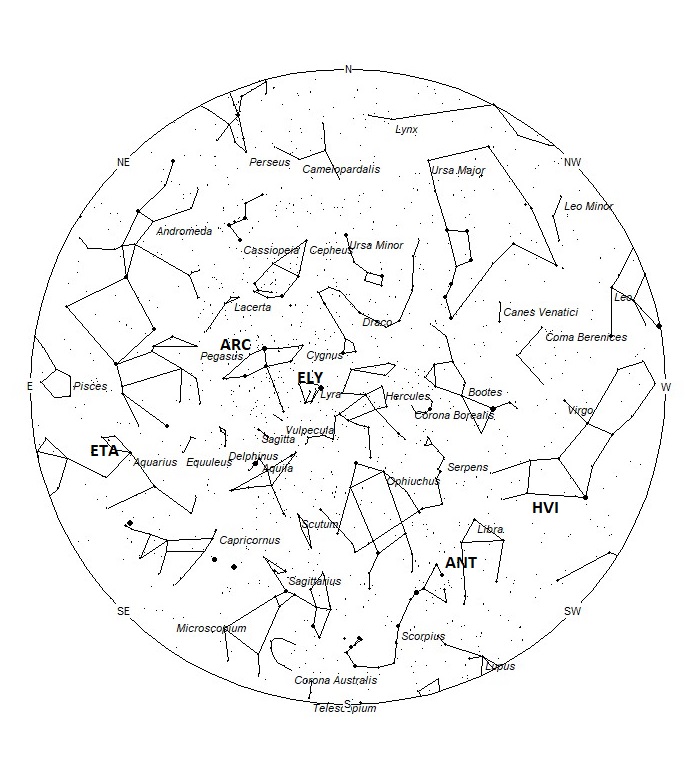
May is the best spring month (in the northern hemisphere) to view meteor activity. The eta Aquariids are very active the first two weeks of the month then fade as the month progresses. These meteors are only visible in the few dark hours prior to dawn. The remainder of the night has low meteor rates. The only other showers of note this month are the eta Lyrids and the Anthelion radiant. These will add only 2-3 meteors per hour to the total count. Sporadic rates are low but steady as seen from the mid-northern hemisphere (45 N). Sporadic rates seen from the tropical southern latitudes (25 S) are strong and remain so the entire month.
During this period the moon reaches its full phase on Thursday May 7th. At this time the moon lies opposite the sun and will remain above the horizon all night long. This weekend the waxing gibbous moon will set during the early morning hours and will provide a small window of opportunity to view under dark skies between moonset and dawn. The estimated total hourly meteor rates for evening observers this week is near 2 for those viewing from the northern hemisphere and 3 for those located south of the equator. For morning observers, the estimated total hourly rates should be near 9 as seen from mid-northern latitudes (45N) and 14 as seen from tropical southern locations (25S). The actual rates will also depend on factors such as personal light and motion perception, local weather conditions, alertness and experience in watching meteor activity. Evening rates are reduced during this period due to moonlight. Note that the hourly rates listed below are estimates as viewed from dark sky sites away from urban light sources. Observers viewing from urban areas will see less activity as only the brighter meteors will be visible from such locations.
The radiant (the area of the sky where meteors appear to shoot from) positions and rates listed below are exact for Saturday night/Sunday morning May 2/3. These positions do not change greatly day to day so the listed coordinates may be used during this entire period. Most star atlases (available at science stores and planetariums) will provide maps with grid lines of the celestial coordinates so that you may find out exactly where these positions are located in the sky. A planisphere or computer planetarium program is also useful in showing the sky at any time of night on any date of the year. Activity from each radiant is best seen when it is positioned highest in the sky, either due north or south along the meridian, depending on your latitude. It must be remembered that meteor activity is rarely seen at the radiant position. Rather they shoot outwards from the radiant, so it is best to center your field of view so that the radiant lies at the edge and not the center. Viewing there will allow you to easily trace the path of each meteor back to the radiant (if it is a shower member) or in another direction if it is a sporadic. Meteor activity is not seen from radiants that are located below the horizon. The positions below are listed in a west to east manner in order of right ascension (celestial longitude). The positions listed first are located further west therefore are accessible earlier in the night while those listed further down the list rise later in the night.
These sources of meteoric activity are expected to be active this week.
.
The last of the h Virginids (HVI) are expected to be seen this weekend. These meteors are active from April 20-May 04 with maximum activity predicted on April 30th. The radiant is currently located at 13:52 (208) -13. This area of the sky is located in eastern Virgo, 5 degrees east of the 1st magnitude star known as Spica (alpha Virginis). This area of the sky is best seen near midnight local daylight saving time (LDST), when it is located highest in the sky. No matter your location, rates are expected to be less than 1 per hour. At 17km/sec. these meteors would produce meteors of very slow velocity.
The center of the large Anthelion (ANT) radiant is currently located at 15:40 (235) -20. This position lies in eastern Libra, 4 degrees west of the 3rd magnitude star known as Acrab (beta Scorpii). Due to the large size of this radiant, Anthelion activity may also appear from southwestern Ophiuchus and northwestern Scorpius as well as eastern Libra. This radiant is best placed near 0100 LDST, when it lies on the meridian and is located highest in the sky. Rates at this time should be near 1 as seen from the northern hemisphere and 2 per hour as seen from south of the equator. With an entry velocity of 30 km/sec., the average Anthelion meteor would be of slow velocity.
The eta Lyrids (ELY) are active from May 6-13 with maximum activity occurring on the 10th. The radiant is currently located at 19:04 (286) +42. This area of the sky is located in northeastern Lyra, 3 degrees northwest of the 4th magnitude star known as eta Lyrae. The radiant is also located 6 degrees northeast of the brilliant zero magnitude star known as Vega (alpha Lyrae). This radiant is best placed during the last hour before dawn when it lies highest above the horizon in a dark sky. Current rates are expected to be less than 1 no matter your location. These meteors are not well seen from locations south of the equator as the radiant does not rise very high into the northern sky. With an entry velocity of 44 km/sec., the average meteor from this source would be of medium velocity.
The April rho Cygnids (ARC) were discovered by Dr. Peter Brown during his meteoroid stream survey using the Canadian Meteor Orbit Radar. These meteors are active from April 26-May 4 with maximum activity occurring on April 28th. The radiant is currently located at 21:42 (325) +48. This area of the sky is located in northeastern Cygnus some 2 degrees north of the 4th magnitude star known as Deneb (rho Cygni). This radiant is best placed during the last hour before dawn when it lies highest above the horizon in a dark sky. Current rates are expected to be less than 1 per hour no matter your location. With an entry velocity of 41 km/sec., the average meteor from this source would be of medium velocity. Note that these meteors are synonymous with the Nu Cygnids (Molau and Rendtel, 2009).
The eta Aquariids (ETA) reach maximum activity on the mornings of May 5th and 6th. The radiant is currently located at 22:21 (335) -02. This area of the sky is located in northeastern Aquarius, close to the 4th magnitude star known as Sadachbia (gamma Aquarii). These meteors are not
visible prior to 0100 LST and are best seen just before the start of dawn when the radiant lies highest in a dark sky. Hourly rates this weekend are expected to range from 10 as seen from the southern tropics to near zero as seen from high northern latitudes. With an entry velocity of 66 km/sec., the average meteor from this source would be of swift velocity.
As seen from the mid-northern hemisphere (45N) one would expect to see approximately 5 sporadic meteors per hour during the last hour before dawn as seen from rural observing sites. Evening rates would be near 2 per hour. As seen from the tropical southern latitudes (25S), morning rates would be near 8 per hour as seen from rural observing sites and 3 per hour during the evening hours. Locations between these two extremes would see activity between the listed figures.
The list below offers the information from above in tabular form. Rates and positions are exact for Saturday night/Sunday morning except where noted in the shower descriptions.
| SHOWER | DATE OF MAXIMUM ACTIVITY | CELESTIAL POSITION | ENTRY VELOCITY | CULMINATION | HOURLY RATE | CLASS |
| RA (RA in Deg.) DEC | Km/Sec | Local Daylight Saving Time | North-South | |||
| h Virginids (HVI) | Apr 30 | 13:52 (208) -13 | 17 | 00:00 | <1 – <1 | IV |
| Anthelions (ANT) | – | 15:40 (235) -20 | 30 | 02:00 | 1 – 2 | II |
| eta Lyrids (ELY) | May 10 | 19:04 (286) +42 | 46 | 05:00 | <1 – <1 | I |
| April rho Cygnids (ARC) | Apr 28 | 21:42 (325) +48 | 42 | 08:00 | <1 – <1 | IV |
| eta Aquariids (ETA) | May 06 | 22:21 (335) -02 | 67 | 09:00 | 5 – 10 | I |
 American Meteor Society
American Meteor Society



what is a class 1 meteor
Chris and All,
Meteor showers, not individual meteors are rated by their strength at maximum activity. A first class shower will exceed 10 shower members per hour at maximum. A second class shower will produce between 5-10 per hour at maximum. A third class shower is a variable but not annual display. Some years they are strong and others they don’t appear at all. Fourth class showers never exceed 5 meteors per hour and are difficult for the inexperienced observer to sort from the random activity that occurs every night.
Thank you Robert. Now that I know the difference it will be all the more fun in counting.